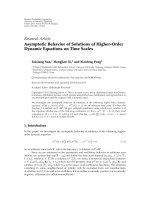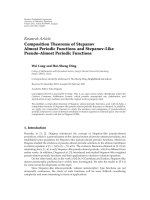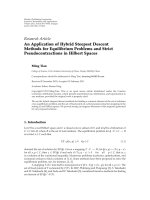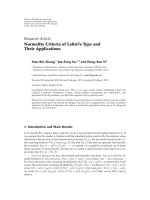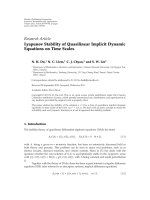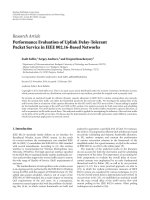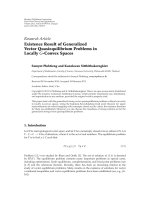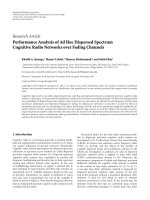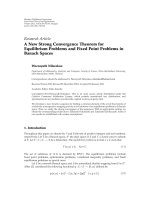Báo cáo hóa học: " Research Article Generalized Zeros of 2 × 2 Symplectic Difference System and of Its Reciprocal System" doc
Bạn đang xem bản rút gọn của tài liệu. Xem và tải ngay bản đầy đủ của tài liệu tại đây (589.15 KB, 23 trang )
Hindawi Publishing Corporation
Advances in Difference Equations
Volume 2011, Article ID 571935, 23 pages
doi:10.1155/2011/571935
Research Article
Generalized Zeros of 2 × 2 Symplectic Difference
System and of Its Reciprocal System
Ondˇrej Doˇsl
´
y
1
and
ˇ
S´arka Pechancov´a
2
1
Department of Mathematics and Statistics, Masaryk University, Kotl
´
a
ˇ
rsk
´
a2,
611 37 Brno, Czech Republic
2
Department of Mathematics and Descriptive Geometry, Faculty of Civil Engineering,
Brno University of Technology,
ˇ
Zi
ˇ
zkova 17, 602 00 Brno, Czech Republic
Correspondence should be addressed to Ond
ˇ
rej Do
ˇ
sl
´
y,
Received 1 November 2010; Accepted 3 January 2011
Academic Editor: R. L. Pouso
Copyright q 2011 O. Do
ˇ
sl
´
yand
ˇ
S. Pechancov
´
a. This is an open access article distributed under
the Creative Commons Attribution License, which permits unrestricted use, distribution, and
reproduction in any medium, provided the original work is properly cited.
We establish a conjugacy criterion for a 2 ×2symplecticdifference system by means of the concept
of a phase of any basis of this symplectic system. We also describe a construction of a 2 × 2
symplectic difference system whose recessive solution has the prescribed number of generalized
zeros in
.
1. Introduction
The main aim of this paper is to establish a conjugacy criterion for the 2 × 2symplectic
difference system
x
k1
u
k1
S
k
x
k
u
k
,k∈
, S
where S
k
a
k
b
k
c
k
d
k
with real-valued sequences a, b, c,andd is such that det S
k
a
k
d
k
−
b
k
c
k
1 for every k ∈ . Recall that under this condition, the matrix S is symplectic. Generally,
a2n × 2n matrix S is symplectic if
S
T
JS J, J
0 I
−I 0
, 1.1
2AdvancesinDifference Equations
I being the n×n identity matrix, and this conditions reduces just to the condition det S 1for
2 ×2 matrices. We introduce concepts of the first and second phase of any basis of system S,
and we study some of their properties. We generalize results introduced in 1–4 for a Sturm-
Liouville difference equation, and we describe how to construct a 2 ×2symplecticdifference
system whose recessive solution has a prescribed number of generalized zeros. This result
generalizes a construction for a Sturm-Liouville difference equation and so solves an open
problem posed in 3,Section4.
The paper is organized as follows. In Section 2, we introduce the definition of the first
phase of any basis of the system S, and we establish a formula for the forward difference of
this phase. We apply this formula to study the relationship between S and its reciprocal
system in Section 3, where the concept of the second phase is introduced. The forward
difference of a first phase of S plays the crucial role in a conjugacy criterion for system
S, which is proved in Section 4.InSection 5, we show how to construct system S with
prescribed oscillatory properties.
Definition of some concepts we need in our paper is now in order. A pair of linearly
independent solutions
x
u
and
y
v
of S with the Casoratian ω
ω ≡ x
k
v
k
− y
k
u
k
const
/
0 1.2
is said to be abasisof the system S.Ifω ≡ 1, it is said to be a normalized basis. An interval
m, m 1, m ∈
,issaidtocontaina generalized zero of a solution
x
u
of S,ifx
m
/
0and
x
m1
0orb
m
x
m
x
m1
< 0. 1.3
Asolution
x
u
of S is said to be oscillatory in
if it has infinitely many generalized zeros
in
. In the opposite case, we say that
x
u
is nonoscillatory in
.SystemS is said to be
nonoscillatory of finite type in
if every solution of S is nonoscillatory in .A nonoscillatory
system S is said to be 1-general in
if it possesses two linearly independent solutions
with no generalized zero, and it is said to be 1-special in
if there is exactly one up to the
linear dependence solution of S without any generalized zero in
. The definition of these
concepts via recessive solutions of S is given later. System S is said to be conjugate in the
interval M, NM, N represents the discrete set M, N ∩
, M, N ∈ , N>M,ifthere
exists a solution of S which has at least two generalized zeros in M − 1,N 1.
Note that the terminology conjugacy/1-general/1-special equation is borrowed from
the theory of differential equations, see 5, 6, and it is closely related to the concepts of
supercriticality/criticality/subcriticality of the Jacobi operators associated with the three-
term recurrence relation
Tx : r
k
x
k1
q
k
x
k
r
k−1
x
k−1
0, 1.4
see 7 and also 8.
At the end of this section, we recall the concept of the recessive solution of S
and its relationship to conjugacy and other concepts defined above. Suppose that S is
nonoscillatory. Then, there exists the unique up to a multiplicative factor solution z
x
u
with the property that lim
k →∞
x
k
/x
k
0 for any solution z
x
u
linearly inde-
pendent of z
.Thesolutionz
is said to be recessive at ∞. The recessive solution z
−
at
Advances in Difference Equations 3
−∞ is defined analogously. System S is 1-special, respectively, 1-general if the recessive
solutions z
,z
−
have no generalized zero in and a re linearly dependent, repectively,
linearly independent. For more details concerning recessive solutions of discrete systems,
we refer to 9, 10.
2. Phases and Their Properties
Definition 2.1. Let
x
k
u
k
and
y
k
v
k
, k ∈
,formabasisofS with the Casoratian ω.Bythefirst
phase of this basis, we understand any real-valued sequence ψ ψ
k
, k ∈ ,suchthat
ψ
k
⎧
⎪
⎪
⎨
⎪
⎪
⎩
arctan
y
k
x
k
if x
k
/
0,
odd multiple of
π
2
if x
k
0,
2.1
with Δψ
k
∈ 0,π if ω>0andΔψ
k
∈ −π, 0 if ω<0.
Here, by arctan, we mean a particular value of the multivalued function which is
inverse to the function tangent. By the requirement Δψ ∈ 0,π, respectively, Δψ ∈ −π, 0,a
first phase of
x
u
,
y
v
is determined uniquely up to mod π.
The first phase and the later introduced second phase are sometimes called zero-
counting sequences, since each jump of their value over an odd multiple of π/2 gives a
generalized zero of a solution of Sor of its reciprocal system as we will show later.
Lemma 2.2. Let
x
u
and
y
v
form a basis of S with the Casoratian ω. Then, there exist sequences h
and g, h
k
/
0, such that the transformation
x
k
u
k
R
k
s
k
c
k
, 2.2
R
k
h
k
0
g
k
ω/h
k
, transforms system S into the so-called trigonometric system
s
k1
c
k1
T
k
s
k
c
k
, T
where T is a symplectic matrix of the form T
k
p
k
q
k
−q
k
p
k
with
p
k
a
k
h
k
b
k
g
k
h
k1
,q
k
ωb
k
h
k
h
k1
.
2.3
Sequences h, g are given by
h
2
k
x
2
k
y
2
k
,g
k
x
k
u
k
y
k
v
k
h
k
.
2.4
4AdvancesinDifference Equations
The values of the sequence h can be chosen in such a way that ωq
k
≥ 0. In particular, if b
k
/
0,then
h
k
can be chosen in such a way that ωq
k
> 0 for k ∈ .
Proof. A similar statement is proved for general 2n ×2n symplectic systems in 11. However,
in contrast to 11, our transformation matrix contains the Casoratian ω, and the proof for
scalar 2 × 2 systems can be simplified.
Transformation 2.2 transforms the symplectic system S into the system
s
k1
c
k1
T
k
s
k
c
k
, T
k
R
−1
k1
S
k
R
k
, 2.5
where T :
a
b
c
d
with
a
k
a
k
h
k
g
k
b
k
h
k1
,
b
k
ωb
k
h
k
h
k1
,
c
k
1
ω
−g
k1
a
k
h
k
b
k
g
k
h
k1
c
k
h
k
d
k
g
k
,
d
k
−b
k
g
k1
d
k
h
k1
h
k
,
2.6
as can be verified by a direct computation. Then
det T
k
det
R
−1
k1
S
k
R
k
det R
−1
k1
det S
k
det R
k
1
ω
· 1 · ω 1,
2.7
which means that T is a symplectic matrix, even if the transformation matric R is not
generally symplectic. This is due to the fact that we consider 2 × 2 systems where a matrix is
symplectic if and only if its determinant equals 1.
We have no index means index k
hh
k1
c
1
ω
−h
x
k1
u
k1
y
k1
v
k1
ah bg
hh
2
k1
ch dg
1
ω
−
x
k1
u
k1
y
k1
v
k1
ah
2
b
xu yv
h
2
k1
ch
2
d
xu yv
1
ω
−
x
k1
u
k1
y
k1
v
k1
x
ax bu
y
ay bv
h
2
k1
x
cx du
y
cy dv
Advances in Difference Equations 5
1
ω
−
x
k1
u
k1
y
k1
v
k1
xx
k1
yy
k1
x
2
k1
y
2
k1
xu
k1
yv
k1
1
ω
−xx
k1
y
k1
v
k1
− yx
k1
y
k1
u
k1
yx
2
k1
v
k1
xy
2
k1
u
k1
1
ω
xy
k1
−x
k1
v
k1
y
k1
u
k1
yx
k1
−y
k1
u
k1
x
k1
v
k1
−xy
k1
yx
k1
−x
ay bu
y
ax bu
−ωb.
2.8
Hence,
b −ωb/hh
k1
−c : q. Similarly,
a −
d
1
hh
k1
ah
2
hgb bg
k1
h
k1
− dh
2
k1
1
hh
k1
ax
2
ay
2
b
xu yv
b
x
k1
u
k1
y
k1
v
k1
− dx
2
k1
− dy
2
k1
1
hh
k1
x
ax bu
y
ay bv
x
k1
bu
k1
− dx
k1
y
k1
bv
k1
− dy
k1
1
hh
k1
xx
k1
yy
k1
− x
k1
x − y
k1
y
0,
2.9
in the last line of this computation, we have used the fact that S
−1
d −b
−ca
,thatis,x
k
d
k
x
k1
− b
k
u
k1
, y
k
d
k
y
k1
− b
k
v
k1
.Hence,a
d : p.
Finally, concerning positivity of ωq if b
/
0, we fix the sign of h in a particular index,
say h
0
x
2
0
y
2
0
and the formula ωq ω
2
b/hh
k1
shows that the sign of h,thatis,h
±
x
2
y
2
,atindicesk
/
0 can be “adjusted” in such a way that ωq
k
> 0ifb
k
/
0.
Remark 2.3. Transformation 2.2 preserves oscillatory properties of transformed systems in
the following sense. If b
k
x
k
x
k1
< 0, that is, b
k
h
k
s
k
h
k1
s
k1
< 0, then since sgnb
k
h
k
h
k1
sgnωq
k
,wehaveusing the positivity of the term ωq
k
b
k
h
k
s
k
h
k1
s
k1
< 0 if and only if
s
k
s
k1
< 0. Note also that x
k1
0 if and only if s
k1
0, since h
k
/
0forallk.
Lemma 2.4 see 12, Lemma 1. Let T be the trigonometric system. There exists the unique (up
to mod 2π) sequence ϕ
k
∈ 0, 2π such that
sin ϕ
k
q
k
, cos ϕ
k
p
k
2.10
and the general solution
s
c
of T takes the form
s
k
c
k
β
sin
ξ
k
α
cos
ξ
k
α
, 2.11
where k ∈
, α, β ∈ and ξ is any sequence such that Δξ
k
ϕ
k
.
6AdvancesinDifference Equations
Lemma 2.5. Let
x
1
u
1
and
x
2
u
2
be a basis of system S with the Casoratian ω,andletT be the
trigonometric system associated to S as formulated in Lemma 2.2. Then, there exists a solution
s
c
of T such that
⎛
⎝
x
1
k
u
1
k
⎞
⎠
⎛
⎝
h
k
0
g
k
ω
h
k
⎞
⎠
c
k
−s
k
,
⎛
⎝
x
2
k
u
2
k
⎞
⎠
⎛
⎝
h
k
0
g
k
ω
h
k
⎞
⎠
s
k
c
k
, 2.12
where k ∈
and h, g are given by 2.4. Further, there exists a sequence ξ such that
s
k
sin ξ
k
,c
k
cos ξ
k
, 2.13
Δξ
k
ϕ
k
, where the sequence ϕ is given by 2.10 and ϕ
k
∈ 0, 2π for every k ∈ .
Proof. By Lemma 2.2, there exist solutions
s
i
c
i
, i 1 , 2, of T such that
⎛
⎝
x
i
k
u
i
k
⎞
⎠
⎛
⎝
h
k
0
g
k
ω
h
k
⎞
⎠
⎛
⎝
s
i
k
c
i
k
⎞
⎠
, 2.14
that is,
s
i
h
−1
x
i
,c
i
−gx
i
hu
i
ω
.
2.15
By a direct computation, we have
s
1
c
2
− c
1
s
2
1
2.16
and after a few steps
s
i
2
c
i
2
1.
2.17
By Lemma 2.4, there exist real constants α
i
, β
i
such that
⎛
⎜
⎝
s
i
k
c
i
k
⎞
⎟
⎠
β
i
⎛
⎝
sin
ξ
k
α
i
cos
ξ
k
α
i
⎞
⎠
, 2.18
Advances in Difference Equations 7
where ξ is an arbitrary sequence such that Δξ
k
ϕ
k
and ϕ is given by 2.10.By2.17,we
have β
i
1, and by 2.16,weobtain
s
1
k
c
2
k
− c
1
k
s
2
k
sin
ξ
k
α
1
cos
ξ
k
α
2
− sin
ξ
k
α
2
cos
ξ
k
α
1
sin
α
1
− α
2
1,
2.19
that is, α
1
− α
2
π/2mod 2π.Hence,s
1
c
2
and c
1
−s
2
what implies 2.12.
Since ξ
k
was an arbitrary sequence such that Δξ
k
ϕ
k
, changing ξ
k
to ξ
k
− α
2
,weget
2.13.
Notation. In the following, by Arctan and Arccot, we mean the principal branches of
the multivalued functions arctan and arccot with the values in −π/2,π/2 and 0,π,
respectively.
Theorem 2.6. Let z
1
x
u
and z
2
y
v
form a basis of S with the Casoratian ω,andletψ be
a first phase of this basis. If b
k
/
0,then
Δψ
k
⎧
⎪
⎪
⎪
⎨
⎪
⎪
⎪
⎩
Arccot
x
k
x
k1
y
k
y
k1
ωb
k
if ω>0,
Arccot
x
k
x
k1
y
k
y
k1
ωb
k
− π if ω<0.
2.20
If b
k
0,thenΔψ
k
0.
Proof. Let T be a trigonometric system associated to S with the basis z
1
,z
2
and with p,
q satisfying 2.3.Letψ be a first phase of this basis. By Lemma 2.5, there exists a solution
s
c
of T such that s
k
sin ξ
k
, c
k
cos ξ
k
and z
1
x
u
, z
2
y
v
satisfy
x
k
h
k
cos ξ
k
,y
k
h
k
sin ξ
k
, 2.21
where h is given by 2.4, Δξ
k
ϕ
k
and ϕ
k
is given by 2.10.Hence,forx
k
/
0,
tan ξ
k
y
k
x
k
2.22
and if x
k
0, then ξ
k
is equal to an odd multiple of π/2. On the other hand, by Definition 2.1
for x
k
/
0
tan ψ
k
y
k
x
k
,
2.23
and if x
k
0, then ψ
k
is equal to an odd multiple of π/2. Consequently,
ψ
k
≡ ξ
k
mod π
, 2.24
8AdvancesinDifference Equations
and it implies since the additive multiple of π to get equality in 2.24 is independent of k
Δψ
k
≡ Δξ
k
. 2.25
For ω>0, we defined in Definition 2.1 that Δψ
k
∈ 0,π. Suppose that b
k
/
0.
According to Lemma 2.2, we can choose q
k
> 0, and then by Lemma 2.4,wecantake
ϕ
k
∈ 0,π.Using2.25,wehaveϕ
k
Δψ
k
,andthuscotΔψ
k
p
k
/q
k
, and hence
Δψ
k
Arccot
p
k
q
k
. 2.26
Let ω<0. Then, we defined Δψ
k
∈ −π, 0 and based on Lemma 2.2,underthe
assumption b
k
/
0, we can choose q
k
< 0andthenϕ
k
∈ π, 2π defined in 2.10.Using
2.25,wehaveϕ
k
Δψ
k
2π, and consequently cotΔψ
k
2πcot Δψ
k
p
k
/q
k
and
Δψ
k
Arccot
p
k
q
k
− π,
2.27
in this case. Finally, if b
k
0, then q
k
0, and we put ϕ
k
0. Hence, by 2.25, Δψ
k
≡
ϕ
k
mod π and since by Definition 2.1 Δψ
k
∈ −π, π,thenwehaveΔψ
k
0.
Summarizing, by a direct computation
p
k
q
k
h
k
ωb
k
a
k
h
k
b
k
g
k
1
ωb
k
a
k
h
2
k
b
k
x
k
u
k
y
k
v
k
.
2.28
Since x
k1
a
k
x
k
b
k
u
k
and y
k1
a
k
y
k
b
k
v
k
,
x
k
x
k1
y
k
y
k1
a
k
h
2
k
b
k
x
k
u
k
y
k
v
k
,
2.29
and this gives, together with 2.26 and 2.27, the conclusion 2.20.
We continue in this section with a statement which justifies why phases are sometimes
called zero-counting sequences. We formulate the statement for a first phase, for a second
phase the statement is similar.
Theorem 2.7. Let ψ be the first phase of S determined by the basis
x
u
,
y
v
.Then,
x
u
has a
generalized zero in k, k 1 if and only if ψ skips over an odd multiple of π/2 between k and k 1.
Proof. Suppose that
x
u
has a generalized zero in k, k 1,thatis,x
k
x
k1
b
k
< 0. By
Lemma 2.5 x
k
h
k
c
k
, y
k
h
k
s
k
,where
c
−s
is a solution of trigonometric T with ωq
k
> 0
Lemma 2.2. Suppose that ω>0, that is, Δψ
k
∈ 0,πfor ω<0 the proof is analogical.
Then,
c
−s
has a generalized zero in k, k 1 which means that c
k
and c
k1
have different
sign. Since c
k
cos ξ
k
, c
k1
cos ξ
k1
,whereξ is a sequence with Δξ
k
Δψ
k
compare 2.25,
ξ
k
and ξ
k1
lay in different intervals whose endpoints form odd multiples of π/2. Conversely,
if ψ skips an odd multiple of π/2 between k and k 1, ξ does also, and reasoning in the same
way as above, we see that
x
u
has a generalized zero in k, k 1.
Advances in Difference Equations 9
Remark 2.8. A slightly modified statement we have in the case when
x
u
has a zero at k1, that
is, x
k
/
0andx
k1
0. More precisely, by the definition of the first phase ψ
k1
2m 1π/2
for some integer m,and,ifψ is increasing, then ψ
k
∈ 2m − 1π/2, 2m 1π/2.
We illustrate the above statements concerning properties of the first phase by the
following example.
Example 2.9. Consider the Fibonacci recurrence relation
x
k2
x
k1
x
k
,k∈ , 2.30
that is,
Δ
−1
k
Δx
k
−1
k
x
k1
0, 2.31
which can be viewed as symplectic system S with the matrix
S
k
⎛
⎝
1
−1
k
−1
k1
0
⎞
⎠
, 2.32
that is, the entry corresponding to b
k
changes its sign. A basis
x
u
,
y
v
of S corresponding
to 2.31 has the first components given by
x
k
1 −
√
5
2
k
,y
k
1
√
5
2
k
,
2.33
with the positive Casoratian ω
√
5. By Definition 2.1, Δψ
k
∈ 0 ,π and
ψ
k
⎧
⎪
⎪
⎪
⎪
⎪
⎪
⎨
⎪
⎪
⎪
⎪
⎪
⎪
⎩
Arctan
1
√
5
1 −
√
5
k
k
2
π, k even,
Arctan
1
√
5
1 −
√
5
k
k 1
2
π, k odd.
2.34
Notice that every jump of the value ψ
k
over an odd multiple of π/2 corresponds to a
generalized zero of x in k, k 1. A corresponding trigonometric system T to symplectic
system S has by Lemma 2.5 two linearly independent solutions
c
−s
and
s
c
,wherethe
sequences c and s are given by 2.13.Sinceby2.24 ξ
k
ψ
k
mπ for some m ∈ ,thefirst
components of a basis of T can be up to the sign uniquely determined by
c
k
cos ψ
k
,s
k
sin ψ
k
. 2.35
It means that the components x, respectively, y of solutions of S have generalized zeros in
k, k 1 if and only if components c, respectively, s of solutions of T have a generalized
10 Advances in Difference Equations
zero in k, k 1.By2.21,togetherwith2.24, we express the first components of the basis
of S as
x
k
h
k
cos ψ
k
,y
k
h
k
sin ψ
k
. 2.36
By Lemma 2.2, we choose the sign of the sequence h in such a way that
,h
0
> 0,h
1
> 0,h
2
< 0,h
3
< 0,h
4
> 0, , 2.37
so the term ωq
k
i.e., b
k
h
k
h
k1
is positive. Such a choice of the sign of the members of h
k
must agree with the sign of sequences x
k
and y
k
. In fact, then by 2.36, y
k
is positive for
any k and x
k
is positive for every even and negative for every odd integer k.
Next, we describe the behavior of the phase ψ and corresponding trigonometric
sequences c and s in case when ω<0. Consider 2.31, that is, the corresponding symplectic
system with the basis
x
u
,
y
v
having the first components
x
k
1
√
5
2
k
,y
k
1 −
√
5
2
k
,
2.38
with the negative Casoratian ω −
√
5. By Definition 2.1,
ψ
k
⎧
⎪
⎪
⎪
⎪
⎪
⎪
⎨
⎪
⎪
⎪
⎪
⎪
⎪
⎩
Arctan
1 −
√
5
1
√
5
k
−
k
2
π, k even,
Arctan
1 −
√
5
1
√
5
k
−
k − 1
2
π, k odd.
2.39
The first components of a basis of the trigonometric system T corresponding to S is of the
form
c
k
cos ψ
k
,s
k
sin ψ
k
. 2.40
Choosing the sign of the sequence h as follows
,h
0
> 0,h
1
> 0,h
2
< 0,h
3
< 0,h
4
> 0, , 2.41
we get x
k
positive for any k and y
k
positive for every even and negative for every odd
integer k.
Advances in Difference Equations 11
3. Reciprocal System
Areciprocalsystemto S is the symplectic system
x
k1
u
k1
S
r
k
x
k
u
k
,k∈
, S
r
where
S
r
k
JS
k
J
−1
d
k
−c
k
−b
k
a
k
, J
01
−10
, 3.1
related to S by the substitution
x
u
J
x
u
. From definition of the symplectic system S
and its reciprocal system S
r
, it follows that if
x
u
is a solution of S,then
u
−x
is a solution
of its reciprocal system S
r
.
Definition 3.1. By the second phase of the basis
x
u
,
y
v
of system S, we understand any first
phase of the basis
u
−x
,
v
−y
of its reciprocal system S
r
, that is, any real-valued sequence
k
, k ∈ ,suchthat
k
⎧
⎪
⎨
⎪
⎩
arctan
v
k
u
k
if u
k
/
0,
odd multiple of
π
2
if u
k
0,
3.2
with Δ
k
∈ 0,π if ω>0andΔ
k
∈ −π, 0 if ω<0.
The proofs of the next statement and of its corollary are the same as those of Lemma 2.2
and Theorem 2.6, respectively.
Lemma 3.2. Let
x
u
and
y
v
form a basis of S with the Casoratian ω,thatis,
u
−x
and
v
−y
is a
basis of S
r
with the Casoratian ω ω −u
k
y
k
x
k
v
k
. Then, there exist sequences h and g, h
k
/
0
for k ∈
, such that the transformation
x
k
u
k
⎛
⎜
⎝
h
k
0
g
k
ω
h
k
⎞
⎟
⎠
s
k
c
k
, 3.3
transforms system S
r
into the trigonometric system
s
k1
c
k1
p
k
q
k
−q
k
p
k
s
k
c
k
T
r
12 Advances in Difference Equations
which is symplectic with the sequences
p, q given by
p
k
d
k
h
k
− c
k
g
k
h
k1
, q
k
−
c
k
ω
h
k
h
k1
,
3.4
where
h
2
k
u
2
k
v
2
k
, g
k
−
x
k
u
k
y
k
v
k
h
k
.
3.5
Moreover, transformation 3.3 preserves oscillatory properties of S
r
, and the sequence h
k
, k ∈ ,
can be chosen in such a way that ω
q
k
≥ 0 and if c
k
/
0 in such a way that ω
q
k
> 0.
Corollary 3.3. Let
x
u
and
y
v
form a basis of S with the Casoratian ω;thatis,
u
−x
and
v
−y
form the basis of S
r
with the same Casoratian ω.Let
k
be the second phase of the basis
x
u
,
y
v
of S.Ifc
k
/
0, k ∈
,then
Δ
k
⎧
⎪
⎪
⎪
⎨
⎪
⎪
⎪
⎩
Arccot
u
k
u
k1
v
k
v
k1
−ωc
k
if ω>0,
Arccot
u
k
u
k1
v
k
v
k1
−ωc
k
− π if ω<0.
3.6
If c
k
0,thenΔ
k
0.
In the next statement, we use the relationship between the first phase ψ and the second
phase of the basis
x
u
,
y
v
of symplectic system S and the fact that the behavior of the
firstandsecondphasesofsystemS plays the crucial role in counting generalized zeros of
solutions of symplectic system S and of its reciprocal system S
r
.
Theorem 3.4. If system S with the sequences b
k
/
0 and c
k
/
0 which do not change their sign has a
solution with two consecutive generalized zeros in l − 1,l,andletm − 1,m, l<m, l, m ∈
,then
its reciprocal system S
r
is either conjugate in l − 1,m with a solution having a generalized zero in
l − 1,l or m − 1,m, or there exists a solution of S
r
with exactly one generalized zero in l, m.
Proof. Let
x
u
be the solution of S having consecutive generalized zeros in l − 1,l and
m −1,m and
y
v
be a solution which together with
x
u
form the basis of the solution space
of S.Denotebyψ and the first and second phase of this basis. Then, by Lemma 2.5,
x
k
h
k
cos ψ
k
,u
k
g
k
cos ψ
k
−
ω
h
k
sin ψ
k
,
y
k
h
k
sin ψ
k
,v
k
g
k
sin ψ
k
ω
h
k
cos ψ
k
,
3.7
and by Lemma 3.2,
u
k
h
k
cos
k
,v
k
h
k
sin
k
.
3.8
Advances in Difference Equations 13
Hence,
h
k
cos
k
g
k
cos ψ
k
−
ω
h
k
sin ψ
k
,
h
k
sin
k
g
k
sin ψ
k
ω
h
k
cos ψ
k
.
3.9
Multiplying the first equation by −sin ψ
k
, the second one by cos ψ
k
, and adding the resulting
equations, we obtain
h
k
sin
k
− ψ
k
ω
h
k
.
3.10
Sinceweassumethatthesequencesb, c are of constant sign, the last part of Lemma 2.2
together with the second formulas in 2.3, 3.4 imply that h and
h have constant sign as
well and by 3.10 thesameholdsforthesequencesin
k
− ψ
k
. Suppose, to be specific, that
sin
k
− ψ
k
< 0 if this sequence is positive, the proof is similar then there exists an odd
integer n such that
nπ <
k
− ψ
k
<
n 1
π. 3.11
Recall that by Definition 2.1,thefirstphaseψ and the second phase are defined as
the monotone sequences on
. In addition, by Lemma 3.2,theCasoratianω of S equals to
the Casoratian
ω of S
r
, and thus, again by Definition 2.1,bothphasesψ and of S are
either nondecreasing or nonincreasing. Moreover, if ω
ω
/
0, b
k
/
0andc
k
/
0, k ∈
,then
by Theorem 2.6 and Corollary 3.3, Δψ
k
/
0andΔ
k
/
0fork ∈
.
Suppose that the first phase ψ
k
of the basis
x
u
,
y
v
of S given by Definition 2.1 is
increasing; that is, for every integer k,wehaveΔψ
k
∈ 0,π. If we suppose a decreasing
sequence ψ, the proof is analogous. Since the p hases are determined up to mod π,without
loss of generality, we may suppose that n −1in3.11,thatis,
0 <ψ
k
−
k
<π. 3.12
Moreover, we can also suppose that ψ
l−1
∈ −π/2,π/2.Sincex has consecutive generalized
zeros in l − 1,l and m − 1,m,wehave
ψ
l
∈
π
2
,
3π
2
,ψ
j
∈
π
2
,
3π
2
,j l 1, ,m− 1,ψ
m
∈
3π
2
,
5π
2
, 3.13
that is, ψ
k
skips π/2 between l −1andl and 3π/2 between m −1andm and stays in the strip
π/2, 3π/2 between l and m.Formula3.12 admits the following behavior of the sequence
to draw a picture may help to visualize the situation.
14 Advances in Difference Equations
i
l−1
< −π/2,
l
∈ −π/2,π/2 ,thereexistsr, l<r<m,suchthat
i
∈
−
π
2
,
π
2
,i l 1, ,r− 1,
j
∈
π
2
,
3π
2
,j r, ,m− 1,
m
∈
3π
2
,
5π
2
.
3.14
ii The sequence has the same behavior as in i up to m,where
m
< 3π/2.
iii We have
l−1
∈ −π/2,π/2 ,
l
∈ −π/2,π/2 and for k>lthe sequence behaves
as in i.
iv We have
l−1
∈
−
π
2
,
π
2
,
l
∈
π
2
,
3π
2
,
j
∈
π
2
,
3π
2
,j l 1, ,m− 1,
m
≥
3π
2
.
3.15
v Finally,
l−1
∈
−
π
2
,
π
2
,
j
∈
−
π
2
,
π
2
,j l, ,r− 1,
r
∈
π
2
,
3π
2
,
j
∈
π
2
,
3π
2
,j r 1, ,m.
3.16
The cases i–iv correspond to conjugacy of S
r
, while the last case corresponds to the
existence of a solution with exactly one generalized zero in l, m − 1.
4. A Conjugacy Criterion
In this section, we establish a conjugacy criterion for system S by means of the first phase ψ
and the associated Riccati equation.
The conjugacy of S in M, N means that there exists a solution of S with at least two
generalized zeros in M−1,N1, that is, ther e exists a solution
x
u
and two intervals l−1,l,
m, m 1,whereM ≤ l<m≤ N,suchthatx
l−1
/
0 and either x
l
x
l−1
b
l−1
< 0orx
l
0, and
x
m
/
0 and either x
m
x
m1
b
m
< 0orx
m1
0. Conversely, we say that system S is disconjugate
in M, N if every solution of S has at most one generalized zero in M − 1,N 1.
Theorem A see 9,Chapter3. If
x
k
u
k
, x
k
/
0, is a solution of S on the interval 0,N1,then
the sequence w
k
u
k
/x
k
is a solution of the Riccati difference equation
w
k1
c
k
d
k
w
k
a
k
b
k
w
k
,
4.1
defined for k ∈ 0,N. Also, if
x
u
has no generalized zero in the interval 0,N 1 and b
k
> 0,then
a
k
b
k
w
k
> 0 for k ∈ 0,N.
Advances in Difference Equations 15
Theorem B see 9, Theorem 5.30,seealso13. Suppose that system S possesses a solution
with no generalized zer o in M, N 1. Then, every nontrivial solution
x
u
of this system has at most
one generalized zero in this interval.
In this section, as usual, we put
n
im
·0ifm>nand
l
ik
·1ifk>l.
Theorem 4.1. Let the sequence b
k
in S be positive. Suppose that there exist positive real numbers
δ
1
and δ
2
such that
N
k0
ArccotA
k
≥
π
4
, 4.2
0
kM1
Arccot B
k
≥
π
4
, 4.3
where M ≤−1 and N ≥ 1 are arbitrary fixed integers,
A
k
2
δ
1
b
k
⎡
⎣
1 b
k
⎛
⎝
δ
1
k−1
j0
F
j
⎞
⎠
⎤
⎦
k−1
j0
1 b
j
δ
1
j−1
i0
F
i
2
,
B
k
2
δ
2
b
k
⎡
⎣
1 b
k
⎛
⎝
δ
2
−1
jk
F
j
⎞
⎠
⎤
⎦
−1
jk1
⎡
⎣
1 b
j
⎛
⎝
δ
2
−1
ij
F
i
⎞
⎠
⎤
⎦
2
,
4.4
F
k
a
k1
− 1
b
k1
d
k
− 1
b
k
.
4.5
Then, system S is conjugate in M, N.
Proof. In the first part of the proof, we show that the solution
x
u
of S given by the condition
x
0
1,x
1
1 4.6
has a generaliz ed zero in 0,N 1.Let
y
v
be another linearly independent solution of S
given by the condition
y
0
1,y
1
1 δ
1
b
0
. 4.7
Since x
k1
a
k
x
k
b
k
u
k
and y
k1
a
k
y
k
b
k
v
k
for every integer k, this holds especially for
k 0, and hence
u
0
1
b
0
x
1
− a
0
x
0
1
b
0
1 −a
0
,
v
0
1
b
0
y
1
− a
0
y
0
1
b
0
1 −a
0
δ
1
.
4.8
16 Advances in Difference Equations
The Casoratian ω satisfies
ω x
0
v
0
− y
0
u
0
δ
1
> 0. 4.9
Suppose, by contradiction, that
x
u
has no generalized zero in 0,N 1,thatis,due
to the fact that x
0
1andb
k
> 0, we have x
k
> 0 for every k 1, 2, ,N. Then, by Theorem
B, we get
y
k
>x
k
, 4.10
for k 1, ,N 1, because otherwise the solution
x
u
−
y
v
has generalized zeros at k 0
and in the interval m, m 1, m being the integer where 4.10 is violated.
Let ψ be the first phase of solutions
x
u
and
y
v
,thatis,byDefinition 2.1,
ψ
k
arctan
y
k
x
k
, Δψ
k
∈
0,π
. 4.11
By Theorem 2.6,wehave
Δψ
k
Arccot
x
k
x
k1
y
k
y
k1
δ
1
b
k
,
4.12
taking account that ψ
0
π/4andusing4.10,wegetfork 1, ,N 1
ψ
k
k−1
j0
Δψ
j
ψ
0
k−1
j0
Arccot
x
j
x
j1
y
j
y
j1
δ
1
b
j
π
4
>
k−1
j0
Arccot
2y
j
y
j1
δ
1
b
j
π
4
.
4.13
Let w
k
v
k
/y
k
. Then, from the first equation in S
w
k
1
b
k
y
k1
y
k
− a
k
,
4.14
and w is a solution of the Riccati equation 4.1.Denote w
k
w
k
a
k
− 1/b
k
. Then,
w
k1
a
k1
− 1
b
k1
c
k
d
k
w
k
−
a
k
− 1
/b
k
a
k
b
k
w
k
−
a
k
− 1
/b
k
a
k1
− 1
b
k1
b
k
c
k
b
k
d
k
w
k
− a
k
d
k
d
k
b
k
b
k
w
k
1
a
k1
− 1
b
k1
−1 d
k
1 b
k
w
k
− b
k
w
k
b
k
w
k
b
k
b
k
w
k
1
a
k1
− 1
b
k1
d
k
− 1
b
k
w
k
1 b
k
w
k
.
4.15
Advances in Difference Equations 17
Further denote F
k
a
k1
−1/b
k1
d
k
−1/b
k
. Then, since 1b
k
w
k
b
k
w
k
a
k
y
k1
/y
k
> 0,
Δ w
k
F
k
−
b
k
w
2
k
1 b
k
w
k
≤ F
k
,
4.16
which means that
w
k
≤ w
0
k−1
j0
F
j
δ
1
k−1
j0
F
j
.
4.17
Hence, 4.14 implies
y
k
y
0
k−1
j0
w
j
b
j
a
j
k−1
j0
b
j
w
j
1
,
4.18
and using 4.17,
y
k
≤
k−1
j0
1 b
j
δ
1
j−1
i0
F
i
.
4.19
Now,
2y
k
y
k1
δ
1
b
k
≤
2
δ
1
b
k
k−1
j0
1 b
j
δ
1
j−1
i0
F
i
k
j0
1 b
j
δ
1
j−1
i0
F
i
2
δ
1
b
k
⎡
⎣
1 b
k
⎛
⎝
δ
1
k−1
j0
F
j
⎞
⎠
⎤
⎦
k−1
j0
1 b
j
δ
1
j−1
i0
F
i
2
A
k
.
4.20
Let k N 1in4.13. Then, together with assumption 4.2,
ψ
N1
>
N
k0
Arccot A
k
π
4
≥
π
2
. 4.21
On the other hand, since
x
u
has no generalized zero in 0,N 1, it follows that ψ
k
<π/2
for every k 0, ,N 1, a contradiction with 4.21. It means that the solution
x
u
has a
generalized zero in 0,N 1.
In the second part of the proof, we show that the solution
x
u
of S given by condition
4.6 has also a generalized zero in M−1, 0.SinceS
−1
d −b
−ca
,wehavex
k
d
k
x
k1
−b
k
u
k1
and u
k
−c
k
x
k1
a
k
u
k1
,inparticular,
x
−1
d
−1
x
0
− b
−1
u
0
d
−1
−
b
−1
b
0
1 −a
0
.
4.22
18 Advances in Difference Equations
Let
y
v
be another linearly independent solution of S given by the condition
y
0
1, y
−1
δ
2
b
−1
d
−1
−
b
−1
b
0
1 −a
0
,
4.23
with the corresponding second component
v
0
expressed by
v
0
1
b
−1
d
−1
y
0
− y
−1
1
b
0
1 −a
0
− δ
2
.
4.24
The Casoratian
ω of
x
u
,
y
v
satisfies
ω x
0
v
0
− y
0
u
0
−δ
2
< 0. 4.25
Suppose, by contradiction, that the solution
x
u
has no generalized zero in the interval M−1,
0,thatis,x
k
> 0fork M, ,0. Then, by Theorem B using the same argument as in the
first part of the proof
y
k
>x
k
, 4.26
for every k M, ,−1. Let
ψ be the first phase of
x
u
and
y
v
with the Casoratian
ω<0.
By Definition 2.1,
ψ
k
arctan
y
k
x
k
, Δψ
k
∈
−π, 0
,
4.27
and by Theorem 2.6
Δ
ψ
k
Arccot
x
k
x
k1
y
k
y
k1
−δ
2
b
k
− π.
4.28
Taking into account that
ψ
0
π/4, 4.26, and that the function Arccot· − π/2 is odd, we
get for every k M, ,−1
−
ψ
k
ψ
0
−1
jk
Δψ
j
−1
jk
Arccot
x
j1
x
j
y
j1
y
j
−δ
2
b
j
−
π
2
−
π
2
−
−1
jk
Arccot
x
j1
x
j
y
j1
y
j
δ
2
b
j
< −
−1
jk
Arccot
2
y
j1
y
j
δ
2
b
j
.
4.29
Advances in Difference Equations 19
Hence,
ψ
k
>
π
4
−1
jk
Arccot
2
y
j
y
j1
δ
2
b
j
.
4.30
Let us estimate the term 2
y
k1
y
k
/b
k
by means of the Riccati equation. Let w
k
v
k
/
y
k
. Then, y
k
d
k
y
k1
− b
k
v
k1
,thatis,
y
k
y
k1
d
k
− b
k
w
k1
, 4.31
and from the backward Riccati equation for
w which follows from 4.1,
w
k
−c
k
a
k
w
k1
d
k
− b
k
w
k1
.
4.32
Put w
k
w
k
− d
k−1
− 1/b
k−1
. Then, substituting into 4.32,wehaveno index mean the
index k here and also in later computations
w
d
k−1
− 1
b
k−1
−c a
w
k1
d − 1
/b
d − b
w
k1
d − 1
/b
a w
k1
−cb ad − a
/b
1 −b w
k1
1/b
a/b
b w
k1
− 1
1 −b w
k1
−
a
b
1/b − w
k1
w
k1
1 −b w
k1
−
a −1
b
w
k1
1 −b w
k1
,
4.33
and hence,
w
k
− w
k1
−
a
k
− 1
b
k
−
d
k−1
− 1
b
k−1
b
k
w
2
k1
1 −b
k
w
k1
.
4.34
Since,
1 −b w
k1
1 − b
w
k1
−
d − 1
b
d − b
w
k1
d − b
c d
w
a bw
ad − cb
a bw
1
a bw
y
k
y
k1
> 0,
4.35
we have −Δ w
k
−≥F
k−1
,whereF
k
is given by 4.5. Summing the last inequality from k 1to
−1, we obtain
− w
k1
w
0
≤
−1
jk1
F
j−1
4.36
20 Advances in Difference Equations
and this means that
1 −b
k
w
k1
≤ 1 b
k
⎛
⎝
− w
0
−1
jk1
F
j−1
⎞
⎠
. 4.37
From 4.31,
y
k
y
k1
d
k
− b
k
w
k1
d
k
− 1
b
k
1 − b
k
w
k1
, 4.38
hence
y
k
1 − b
k
w
k1
y
k1
,thatis,from4.37,
y
k
y
0
−1
jk
1 −b
j
w
j1
≤
−1
jk
⎡
⎣
1 b
j
⎛
⎝
− w
0
−1
ij1
F
i−1
⎞
⎠
⎤
⎦
. 4.39
Finally,
w
0
w
0
−
d
−1
− 1
b
−1
−δ
2
1 −a
0
b
0
−
d
−1
− 1
b
−1
−δ
2
− F
−1
,
4.40
this implies
y
k
≤
−1
jk
⎡
⎣
1 b
j
⎛
⎝
δ
2
−1
ij
F
i
⎞
⎠
⎤
⎦
. 4.41
Substituting from 4.30,
ψ
M
>
π
4
−1
kM
Arccot
2
δ
2
b
k
⎡
⎣
1 b
k
⎛
⎝
δ
2
−1
jk
F
j
⎞
⎠
⎤
⎦
−1
jk1
⎡
⎣
1 b
j
⎛
⎝
δ
2
−1
ij
F
i
⎞
⎠
⎤
⎦
2
,
4.42
and hence
ψ
M
>
−1
kM
Arccot B
k
π
4
≥
π
2
. 4.43
On the other hand, since we suppose that
x
u
has no generalized zero in M − 1, 0,itholds
ψ
M
<π/2, a contradiction with 4.43.
Summarizing, we have proved that the solution
x
u
has at least one generalized zero
in M − 1, 0 and one generalized zero in 0,N 1. The proof is complete.
Advances in Difference Equations 21
Remark 4.2. The conjugacy criterion for the Sturm-Liouville equation
Δ
r
k
Δx
k
q
k
x
k1
0,r
k
> 0, 4.44
formulated in 1,Theorem2 is the corollary of the above criterion for a
k
1, b
k
1/r
k
,
c
k
−q
k
and d
k
1 − q
k
/r
k
. Theorem 4 .1 also extends the results proved in 1, 2, 12, 14.
5. Systems with Prescribed Oscillatory Properties
In this concluding section, we present a method of constructing a symplectic system S
whose recessive solution has the prescribed number of generalized zeros in
.
Theorem 5.1. Suppose that
x
u
,
y
v
∈
2
, k ∈ , are sequences such that the Casoratian ω
det
x
k
y
k
u
k
v
k
1 for any k ∈
. Then, these sequences form a normalized basis of symplectic system S
with
a
k
x
k1
v
k
− y
k1
u
k
,
b
k
−x
k1
y
k
y
k1
x
k
,
c
k
u
k1
v
k
− v
k1
u
k
,
d
k
−u
k1
y
k
v
k1
x
k
.
5.1
Moreover, if b
k
/
0 for k ∈
,
lim
k →±∞
x
k
y
k
0,
5.2
and
x
u
has m − 1 generalized zeros in
, then the first phase determined by
x
u
,
y
v
satisfies
lim
k →∞
ψ
k
− lim
k →−∞
ψ
k
k∈ ,b
k
/
0
Arccot
x
k
x
k1
y
k
y
k1
b
k
mπ.
5.3
Proof. Let
x
u
and
y
v
be sequences with the Casoratian equal to 1, and let a, b, c,andd be
given by 5.1. Then, by the Cramer rule, we obtain
x
k1
a
k
x
k
b
k
u
k
,
u
k1
c
k
x
k
d
k
u
k
,
y
k1
a
k
y
k
b
k
v
k
,
v
k1
c
k
y
k
d
k
v
k
,
5.4
so
x
u
and
y
v
are solutions of S with a, b, c, d given by 5.1.Itiseasytoverifythat
a
k
d
k
− b
k
c
k
1 holds for any integer k; that is, system S is symplectic. Now, suppose that
22 Advances in Difference Equations
assumptions of the second part of the theorem are satisfied. Then, S is nonoscillatory in
and
x
u
is its recessive solution both in ∞ and −∞.Since
Δ
y
k
x
k
Δy
k
x
k
− Δx
k
y
k
x
k
x
k1
y
k1
x
k
− x
k1
y
k
x
k
x
k1
a
k
y
k
b
k
v
k
x
k
−
a
k
x
k
b
k
u
k
y
k
x
k
x
k1
b
k
x
k
x
k1
> 0,
5.5
for large and small k, the limits lim
k →±∞
y
k
/x
k
exist and by 5.2 lim
k →∞
y
k
/x
k
∞ lim
k →−∞
y
k
/x
k
−∞. It follows, by the definition of the first phase, that limits lim
k →∞
ψ
k
>
lim
k →−∞
ψ
k
also exist and equal to odd multiples of π/2. This, coupled with the fact that
x
u
has exactly m − 1 generalized zeros in
;thatis,ψ
k
equals m − 1 times an odd multiple of
π/2 or skips over this multiple, gives 5.3.
We finish the paper with an example illustrating the previous theorem.
Example 5.2. Consider a pair of two-dimensional sequences
x
u
,
y
v
with
x
k
k
1
2
n−1
,u
k
n − 1
k 3/2
n
,
y
k
k
1
2
n
,v
k
n
k 3/2
n−1
,
5.6
where n ≥ 1andk α
n
:k α ···k α −n 1. By a direct computation, one can verify
that x
k
v
k
− y
k
u
k
1andthat5.1 read
a
k
1,
b
k
k
3
2
k
1
2
2
···
k − n
7
2
2
k − n
5
2
,
c
k
−n
n − 1
k 5/2
k 3/2
2
···
k − n 7/2
2
k − n 5/2
,
d
k
k 5/2
k 3/2
− n
n − 1
k 5/2
k 3/2
.
5.7
Obviously, lim
k →±∞
x
k
/y
k
0, so the assumptions of the previous theorem are satisfied, and
since
x
k
x
k1
b
k
k
3
2
2
k
1
2
4
···
k − n
7
2
4
k − n
5
2
2
> 0,
5.8
Advances in Difference Equations 23
for k ∈
,thesolution
x
u
has no generalized zero in
.Consequently,5.3 reads as can be
again verified by a direct computation
k∈
Arccot
k
2
4 −2n
k n
2
− 4n
19
4
π.
5.9
By a similar method, one can find the explicit formula for the sum of various infinite series
involving the function Arccot.
Acknowledgments
Research supported by the Grants nos. 201/09/J009 and P201/10/1032 of the Czech Grant
Agency and by the Research Project no. MSM0021622409 of the Ministry of Education of the
Czech Government.
References
1 Z. Do
ˇ
sl
´
aand
ˇ
S. Pechancov
´
a, “Conjugacy and phases for second order linear difference equation,”
Computers & Mathematics with Applications, vol. 53, no. 7, pp. 1129–1139, 2007.
2 I. Kumari and S. Umamaheswaram, “Conjugacy criteria for a linear second order difference
equation,” Dynamic Systems and Applications, vol. 8, no. 3-4, pp. 533–546, 1999.
3
ˇ
S. Pechancov
´
a, Phases and oscillation theory of second order difference equations, Ph.D. thesis, Masaryk
University, Brno, Czech Republic, 2007.
4
ˇ
S. Ryz
´
ı, “On the first and second phases of 2×2symplecticdifference systems,” Studies of the University
of
ˇ
Zilina. Mathematical Series, vol. 17, no. 1, pp. 129–136, 2003.
5 O. Bor
˚
uvka, Linear Differential Transformations of the Second Order, The English Universities Press,
London, UK, 1971.
6 F. Neuman, Global Properties of Linear Ordinary Differential Equations,vol.52ofMathematics and Its
Applications (East European Series), Kluwer Academic Publishers, Dordrecht, The Nethrlands, 1991.
7 F. Gesztesy and Z. Zhao, “Critical and subcritical Jacobi operators defined as Friedrichs extensions,”
Journal of Differential Equations, vol. 103, no. 1, pp. 68–93, 1993.
8 O. Do
ˇ
sl
´
y and P. Hasil, “Critical higher order Sturm-Liouville difference operators,” to appear in
Journal of Difference Equations and Applications.
9
C. D. Ahlbrandt and A. C. Peterson, Discrete Hamiltonian Systems. Difference Equations,vol.16ofKluwer
Texts in the Mathematical Sciences, Kluwer Academic Publishers, Dordrecht, The Nethrlands, 1996.
10 M. Bohner, O. Do
ˇ
sl
´
y, and W. Kratz, “A Sturmian theorem for recessive solutions of linear Hamiltonian
difference systems,” Applied Mathematics Letters, vol. 12, no. 2, pp. 101–106, 1999.
11 M. Bohner and O. Do
ˇ
sl
´
y, “Trigonometric transformations of symplectic difference systems,” Journal
of Differential Equations, vol. 163, no. 1, pp. 113–129, 2000.
12 Z. Do
ˇ
sl
´
aandD.
ˇ
Skrab
´
akov
´
a, “Phases of linear difference equations and symplectic systems,”
Mathematica Bohemica, vol. 128, no. 3, pp. 293–308, 2003.
13 M. Bohner, O. Do
ˇ
sl
´
y, and W. Kratz, “Sturmian and spectral theory for discrete symplectic systems,”
Transactions of the American Mathematical Society, vol. 361, no. 6, pp. 3109–3123, 2009.
14 O. Do
ˇ
sl
´
yandP.
ˇ
Reh
´
ak, “Conjugacy criteria for second-order linear difference equations,” Archivum
Mathematicum (Brno), vol. 34, no. 2, pp. 301–310, 1998.
